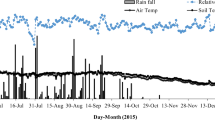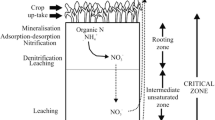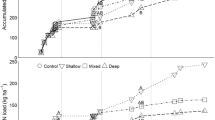Abstract
Experiments were conducted to monitor the movement and distribution of ammonium-N after placement of urea and ammonium sulfate supergranules at 5, 7.5, 10, and 15 cm. By varying depths of fertilizer placement, it is possible to determine the appropriate depth for placement machines. There were no significant differences in grain yields with nitrogen placed 5 and 15 cm deep. However, grain yields were significantly higher with deep placement of nitrogen than with split application of the fertilizer. The lower yields with split-applied nitrogen were due to higher nitrogen losses from the floodwater. The floodwater with split application had 78–98µg N ml−1 and that with deep-placed nitrogen had a negligible nitrogen concentration.
Movement of NH +4 -N in the soil was traced for various depths after fertilizer nitrogen application. The general movement after deep-placement of the ammonium sulfate supergranules was downward > lateral > upward from the placement site. Downward movement was prevalent in the dry season: fertilizer placed at 5–7.5 cm produced a peak of NH +4 -N concentration at 8–12 cm soil depth; with placement at 15 cm, the fertilizer moved to 12–20 cm soil depth. Fertilizer placed at 10 cm tended to be stable. In the wet season, deep-placed N fertilizer was fairly stable and downward movement was minimal.
A substantially greater percentage of plant N was derived from15N-depleted fertilizer when deep-placed in the reduced soil layer than that applied in split doses. The percent N recovery with different placement depths, however, did not vary from each other. The results suggest that nitrogen placement at a 5-cm soil depth is adequate for high rice yields in a clayey soil with good water control. In farmers' fields where soil and water conditions are often less than ideal, however, it is desirable to place nitrogen fertilizer at greater depths and minimize NH +4 -N concentration in floodwater.
Similar content being viewed by others
References
Abichandani CT and Patnaik S (1955) Proper placement of fertilizers. Rice News Teller 3, 12–17
Bilal IM (1977) Transformation and transport of NH +4 -N in a flooded soil. Z Pflanzenernaehr Bodenk 140, 199–207
Bremner JM (1965a) Isotope-ratio analysis. In Methods of Soil Analysis. Part 2. pp 1256–1286. Ed. CA Black. Am Soc Agron, Madison, Wisconsin
— (1965b) Total nitrogen. In Methods of Soil Analysis. Part 2. pp 1149–1176. Ed. CA Black. Am Soc Agron, Madison, Wisconsin
Broadbent FE and Mikkelsen DS (1968) Influence of placement on uptake of tagged nitrogen by rice. Agron J 60, 574–577
Cao Zhi-Hong, De Datta SK and Fillery IRP (1982) Effects of placement methods on recovery of applied nitrogen (15N-labeled urea) in lowland rice. Paper presented at the 13th Annual Scientific Meeting of the Crop Science Society of the Philippines, April 28–30, 1982, Ecotech Center, Lahug, Cebu City, Philippines
Craswell ET and Vlek PLG (1979) Fate of fertilizer nitrogen applied to wetland rice. In Nitrogen and Rice. pp 175–192. Int Rice Res Inst, Los Baños, Philippines
—, De Datta SK, Obcemea WN and Hartantyo M (1981) Time and mode of nitrogen fertilizer application to tropical wetland rice. Fert Res 2, 247–259
De Datta SK (1978) Fertilizer management for efficient use in wetland rice soils. In Soils and Rice. pp 671–701. Int Rice Res Inst, Los Baños, Philippines
De Datta SK (1981) Principles and Practices of Rice Production. New York: John Wiley and Sons, 618 p
— and Craswell ET (1980) Nitrogen fertility and fertilizer management in wetland rice soils. In Rice Research Strategies for the Future. pp 283–316. Int Rice Res Inst, Los Baños, Philippines
-, Magnaye CP and Moomaw JC (1968) Efficiency of fertilizer nitrogen (15N-labelled) for flooded rice. In IV Trans 9th Int Soil Sci Congr pp 67–76. Adelaide, Australia
-, Saladaga FA, Obcemea WN and Yoshida T (1974) Increasing efficiency of fertilizer nitrogen in flooded tropical rice. In Proc. FAI-FAO seminar on optimizing agricultural production under limited availability of fertilizers. pp 265–288. New Delhi, India. December 13–14
Denmead OT, Simpson JR and Freney JR (1967) A Direct field measurement of ammonia emission after injection of anhydrous ammonia. Soil Sci Soc Am J 41, 1001–1004
Douglas LA and Bremner JM (1970) Extraction and colorimetric determination of urea in soils. Soil Sci Soc Amer Proc 34, 859–862
Edwards AP and Hauck RD (1974)15N-depleted versus15N-enriched ammonium sulfate as tracers in nitrogen uptake studies. Soil Sci Soc Am Proc 38, 765–767
Fillery IRP, Simpson JR, De Datta SK, Flordelis E, Menguito C, Castillo E, and Rosario M del (1982) Review of the current research on the role of ammonia volatilization as a nitrogen loss mechanism in wetland rice topdressed with urea. IRRI Saturday seminar (Mimeo). 27 p. Int Rice Res Inst, Los Baños, Philippines
Freney JR, Denmead OT, Watanabe I and Craswell ET (1981) Ammonia and nitrous oxide losses following applications of ammonium sulphate to flooded rice. Aust J Agric Res 32, 37–45
Haque I and Ibrahim M (1965) The influence of sources of nitrogen texture of soil and comments. In Nitrogen and Rice. pp 73–93. Int Rice Res Inst, Los Baños, 1(2), 1–13
Hauck R (1979) Methods for studying N transformation in paddy soils: review and comments. In Nitrogen and Rice. pp 73–93. Int Rice Res Inst, Los Banos, Philippines
IRRI (International Rice Research Institute) (1975) Annual report for 1974. Los Baños, Philippines
- (1978) Annual report for 1977. Los Baños, Philippines
- (1979) Annual report for 1978. Los Baños, Philippines
Keeney DR and Bremner JM (1967) Determination and isotope ratio analysis of different forms of nitrogen in soils: 7. Urea Soil Sci Soc Am Proc 31, 317–321
Kissel DE, Brewer HL and Arkin GF (1977) Design and test of a field sampler for ammonia volatilization. Soil Sci Soc Am J 41, 1133–1138
Koyama T (1975) Practice of determining potential nitrogen supplying capacities of paddy soils and rice yields. (in Japanese). J Sci Soil Manure (Japan) 46, 260–269
Koyama T and Niamsrichand N (1973) Soil-plant nutrition studies on tropical rice. VI. The effect of different levels of nitrogeneous fertilizer application on plant growth, grain yield and nitrogen utilization by rice plants. Soil Sci Plant Nutr (Tokyo) 19(4), 265–274
Lemon E (1977) Nitrous oxide (N2O) exchange at the land surface. In Nitrogen in the environment. Proc workshop, Nitrogen in relation to environmental quality. 31 Jan–3 Feb 1977. Eds. DR Nielson and JG MacDonald. Academic Press, Lake Arrowhead, California
Lung-Yie C and Ching-Cheng F (1978) Effect of deep application of prilled ammonium bicarbonate on the nitrogen supplying status of non-calcareous paddy soils. Acta Pedol Sin 15, 81–91
Mikkelsen DS and De Datta SK (1979) Ammonia volatilization from wetland rice soils. In Nitrogen and Rice. pp 135–150. Int Rice Res Inst, Los Baños, Philippines
—, De Datta SK and Obcemea WN (1978) Ammonia volatilization losses from flooded rice soil. Soil Sci Soc Am J 42, 725–730
Mitsui S (1977) Recognition of the importance of denitrification and its impact on various improved and mechanized applications of nitrogen to rice plant. In Society of the Science of Soil and Manure. Japan. Proc. International Seminar on Soil Environment and Fertility Management in Intensive Agriculture (SEFMIA). pp 259–268. Tokyo, Japan
Murayama N (1979) The importance of nitrogen for rice production. In Nitrogen and Rice. pp 5–23. Int Rice Res Inst, Los Baños, Philippines
Pang PC, Hedlin RA and Cho CM (1973) Transformation and movement of bandapplied urea, ammonium sulfate and ammonium hydroxide during incubation in several Manitoba soils. Can J Soil Sci 53, 331–341
Patrick WN and Mahapatra IC (1968) Transformation and availability to rice of nitrogen and phosphorus in waterlogged soils. Adv Agron 20, 323–359
Patrick WH, Delaune RD and Peterson FJ (1974) Nitrogen utilization by rice using15N-depleted ammonium sulfate. Agron J 66, 819–820
Philips RE and Brown DA (1964) Ion diffusion. II. Comparison of apparent self and counter diffusion coefficients. Soil Sci Soc Am Proc 28, 758–763
Ponnamperuma FN (1955) The chemistry of submerged soil in relation to the growth and yield of rice. Ph D thesis, Cornell Univ, New York. 208 p
— (1977) Physicochemical properties of submerged soils in relation to fertility. RRI Res Pap Ser 5, 1–32. Int Rice Res Inst, Los Baños, Philippines
Racho VV and De Datta SK (1968) Nitrogen economy of cropped and uncropped flooded rice soils under field conditions. Soil Sci 105, 419–427
Reddy KR and Patrick WH (1976) Yield and nitrogen utilization by rice as affected by method and time of application of labeled nitrogen. Agron J 68, 965–969
Reddy KR, Patrick WH and Philips RE (1976) Ammonium diffusion as a factor in nitrogen loss from flooded soils. Soil Sci Am J 40, 528–533
Savant NK and De Datta SK (1979) An undisturbed core sampling and sectioning technique for wetland rice soils. Comm Soil Sci Plant Anal 10(4), 775–783
Savant NK and De Datta SK (1980) Movement and distribution of ammonium N following deep placement of urea in a wetland rice soil. Soil Sci Soc Am J 44(3), 559–565
— and Craswell ET (1982) Distribution patterns of ammonium nitrogen and15N-uptake by rice after deep placement of urea supergranules in wetland soil. Soil Sci Soc Am J 46, 567–573
Starr JL, Broadbent FE and Stout PR (1974) A Comparison of15N-depleted and15N-enriched fertilizer as tracers. Soil Sci Soc Am Proc 38, 266–267
Varley JA (1966) Automatic methods for the determination of nitrogen, phosphorus and potassium in plant material. Analyst 91, 119–125
Ventura W and Yoshida T (1978) Distribution and uptake of rice plants of15N-labelled ammonium applied in mudballs in paddy soils. Soil Sci Plant Nutr 24, 473–479
Vlek PLG, Bryner BH and Craswell ET (1980) Effect of urea placement on leaching losses on nitrogen from flooded rice soils. Plant Soil 54, 441–449
Wetselaar R, Shaw T, Firth P, Oupathum J and Thitipoca H (1977) Ammonia volatilization losses from variously placed ammonium sulfate under lowland rice field conditions in Central Thailand. In Proc Int Seminar on Soil Environment and Fertility Management in Intensive Agriculture (SEFMIA). pp 282–288. Tokyo, Japan
Author information
Authors and Affiliations
Rights and permissions
About this article
Cite this article
Obcema, W., De Datta, S. & Broadbent, F. Movement and distribution of fertilizer nitrogen as affected by depth of placement in wetland rice. Fertilizer Research 5, 125–148 (1984). https://doi.org/10.1007/BF01052711
Accepted:
Issue Date:
DOI: https://doi.org/10.1007/BF01052711




